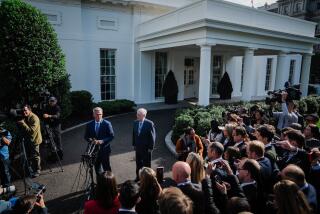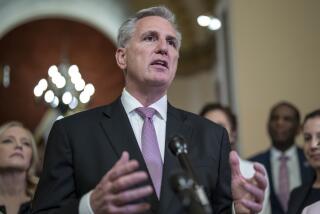Stimulus may be just first chapter
- Share via
WASHINGTON — If the fight to end the economic crisis is a war, the stock market’s continuing dive, deepening troubles in the global economy and recent developments at home show that the enemy still has the upper hand -- and we’re going to need reinforcements. Maybe massive reinforcements.
That could be a tough sell in Washington, where the rapidly increasing price tag is leading many Republicans and some conservative Democrats to adopt an old battle cry: Hell no, we won’t go.
Yet the alternative to additional federal spending on a huge scale could be that the present crisis could not only worsen but continue, not for months or a couple of years but for a decade or more -- as an eerily similar financial system crash did in Japan during the 1990s.
“You could have a ‘lost decade’ just like Japan did,” said Simon Johnson, an economist at the Massachusetts Institute of Technology and former chief economist at the International Monetary Fund. “Anybody who says it’s not possible isn’t paying attention.”
Over the last year, Washington has approved a series of what seemed like eye-popping plans to help the various parts of the foundering economy, including last fall’s $700-billion financial bailout and the $787-billion stimulus package signed into law by President Obama last week. Each time, Congress has almost choked, embracing the proposals only after bitter partisan fights -- and by the narrowest of margins.
“These things are not big relative to the scale of the problem,” said Johnson, who co-founded the Baseline Scenario, a blog on the economic crisis. “Unfortunately, we’re almost certainly going to have to do more.”
And on Thursday, Obama is to outline his budget for the 2010 fiscal year. It could include a federal deficit even greater than the record $1.2 trillion projected for 2009, which doesn’t even include the new stimulus spending.
Beyond the budget, significantly more deficit spending is coming, in the form of a new bailout plan for the still-sinking financial system and possibly a second stimulus package.
“The upfront costs are going to continue to rise,” said Adam Posen, deputy director of the Peterson Institute for International Economics, who predicted at least $1 trillion more will be needed. “They’re going to have to buy a bunch of bad assets from the banks in one form or another, and they’re probably going to have to put more capital into the banks.”
Partly to prepare the way for those unwelcome prospects, Obama has been traveling the country warning that fighting the recession will be expensive and cautioning against expectations of a quick recovery.
“We will need to do everything in the short term to get our economy moving again, while at the same time recognizing that we have inherited a trillion-dollar deficit, and we need to begin restoring fiscal discipline and taming our exploding deficits over the long term,” Obama said before signing the stimulus bill in Denver on Tuesday. “None of this will be easy.”
To further amplify that message, Obama will convene a White House summit on financial responsibility Monday, in part to burnish his claim that he will practice thrift once the present emergency has passed.
But recovery still appears a long way off, especially after last week.
The Federal Reserve downgraded its 2009 forecast, projecting the economy would shrink as much as 1.3% and the unemployment rate would rise to as high as 8.8%. It is at 7.6% now.
Stock markets here and abroad tanked as fears rose that the deepening worldwide recession would lead the Obama administration to nationalize major banks. (The White House said Friday that it does not plan to take that step.)
But beyond the markets’ passing fears or hopes about specific government policies or other developments, what was really eroding securities values was the objective reality of economic trouble almost everywhere -- with no clear notion of what could reverse the tide.
General Motors and Chrysler submitted financial viability plans to the federal government asking for nearly $22 billion in government loans to stave off imminent bankruptcy -- on top of the $17.4 billion they already received.
And on Wednesday, Obama unveiled a housing foreclosure plan partially funded with $50 billion from what remains of the financial rescue fund -- called TARP, for Troubled Assets Relief Program -- approved in the waning days of the Bush administration. That increased the likelihood that Obama will need to ask for more TARP money for the still-being-developed public/private partnership to buy “toxic” assets clogging the balance sheets of financial institutions.
Only about $300 billion remains in the original $700-billion TARP fund, which also must pay for any additional loans to the automakers.
“I don’t see how that’s going to cover the cost of the financial system bailout, let alone the auto industry,” said economist Mark Zandi of Moody’s Economy.com, who predicts the administration will need to ask for an additional $350 billion this year or early in 2010.
Congress members are unlikely to welcome such a request, particularly Republicans already concerned about runaway government spending.
“If they come back, it will not be a surprise,” Sen. Bob Corker (R-Tenn.) said. “As to how that’s received, I think it will be based on the way things are carried out in the interim.”
More clarity about how the Obama administration is spending the stimulus and other money would help with Congress, Posen said. Much of the backlash on Capitol Hill stems from how the Bush administration sold the $700-billion bailout last fall as necessary to buy toxic assets, then changed direction to inject money into banks.
“I am hopeful if the Obama administration goes to Congress and says explicitly, ‘This is what we need and this how we’re going to use it,’ Congress in the end would get a majority to support it,” Posen said.
The administration has promised more transparency in its spending and last week launched the website Recovery.gov so people could track stimulus spending.
And Monday’s summit is intended to highlight fiscal accountability and restraint amid the blizzard of cash flowing out of Washington.
Obama and Vice President Joe Biden will “lead a frank discussion on how we can address the long-term fiscal problems facing this country,” White House Press Secretary Robert Gibbs said.
About 130 people will attend, including Zandi and other economists; Democratic and Republican congressional leaders; and business and labor officials. The event will feature discussion groups led by senior administration officials focusing on major economic challenges, such as healthcare and Social Security.
“The summit’s a first step in the process of beginning to lay out how we can bring down the deficit and put our economy back on sound financial footing,” Gibbs said.
But before the deficit can come down, it will probably continue to rise in what’s shaping up as a drawn-out war against the recession, economists said.
--
jim.puzzanghera @latimes.com
More to Read
Inside the business of entertainment
The Wide Shot brings you news, analysis and insights on everything from streaming wars to production — and what it all means for the future.
You may occasionally receive promotional content from the Los Angeles Times.









